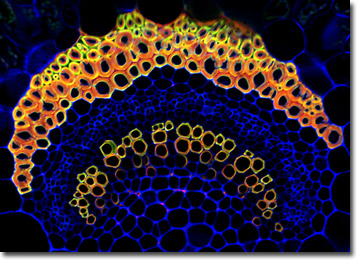 |
 |
 |
|
||||||||||||||||||||||||
 | ||||||||||||||||||||||||
 | ||||||||||||||||||||||||
 | ||||||||||||||||||||||||
Confocal Microscopy Image Gallery
Plant Tissue Autofluorescence Gallery
Carnation Leaf
Carnations have a long history of use by humans, having been cultivated for more than 2,000 years. The flowering plants are native to the Mediterranean and were remarked upon by the ancient Greek philosopher Theophrastus (371-286 BC), whose works on botany were foundational to the field. The earliest carnations were single-flowered and a fleshy pink, and from this variety all others were derived.

Carnations are now available in most every color imaginable and a wide array of sizes. They are one of the most popular cut flowers and are widely utilized on special occasions, such as weddings and Mother’s Day. Symbolic meaning is often ascribed to the specific color of carnation given or worn on these occasions. For instance, red carnations are commonly associated with passionate love, while pink carnations are generally considered symbolic of the kind of love present between a mother and her child.
The scent of carnations is spicy, and the plants have been used in the past to spice wine and other alcoholic beverages, especially when other seasonings proved too expensive. Carnations are said to taste similar to cloves, and are occasionally featured in fruit salads and other dishes. The fragrant petals of the carnation have also found use in soaps, scented waters, scrubs, perfumes, and various other bath-related items.
The species name of the carnation is Dianthus caryophyllus, and the flower belongs to the family Caryophyllaceae, also known as the pink family. Carnations and other pinks characteristically exhibit fringed, or “pinked,” petals and stems with nodular swelling. The leaves of most carnations are narrow and bluish-green in color. Some carnations blossom almost all year round in hothouses, but in the wild most types of the plant bloom mid-summer to early fall.
Contributing Authors
Nathan S. Claxton, Shannon H. Neaves, and Michael W. Davidson - National High Magnetic Field Laboratory, 1800 East Paul Dirac Dr., The Florida State University, Tallahassee, Florida, 32310.
